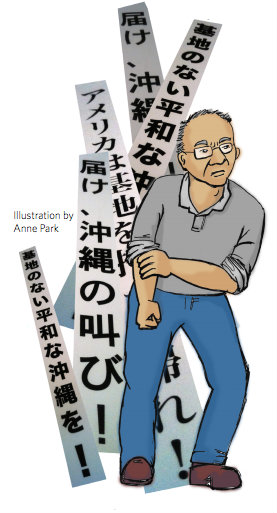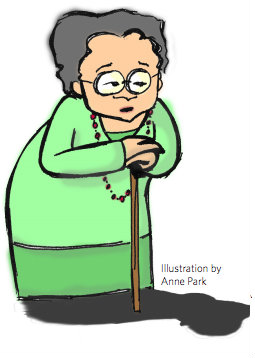Memory and Pacifism
 Okinawa is ambiguous. It is an idyllic, subtropical vacation spot in the eyes of most Japanese as well as the site of the 1945 Battle of Okinawa, the largest land-sea-air battle of World War II. Okinawa is one of 47 prefectures in Japan, but it also doubles as a home to 14 U.S. military bases which in total occupy one-fifth of the island. Its advantageous geographical location allows easy access to East Asia and the Middle East, making the island indispensable for U.S. forces. As long as Japan wants to maintain peaceful diplomatic relations with the U.S., Tokyo will not ease the burden of the bases on the Okinawans.
To some, Okinawa is a ghostly reminder of the devastations of war.
Okinawa is ambiguous. It is an idyllic, subtropical vacation spot in the eyes of most Japanese as well as the site of the 1945 Battle of Okinawa, the largest land-sea-air battle of World War II. Okinawa is one of 47 prefectures in Japan, but it also doubles as a home to 14 U.S. military bases which in total occupy one-fifth of the island. Its advantageous geographical location allows easy access to East Asia and the Middle East, making the island indispensable for U.S. forces. As long as Japan wants to maintain peaceful diplomatic relations with the U.S., Tokyo will not ease the burden of the bases on the Okinawans.
To some, Okinawa is a ghostly reminder of the devastations of war.
“Just looking at these pictures terrifies me,” an old woman said, partly to herself, while looking at a photo of a wounded Okinawan child at an exhibition in Naha City. “War is terrifying. Terrifying.”
She repeated this for a while and sat down on a chair nearby, exhausted. Her occupation was to tell war stories to youths like me. Mrs. H., as I’ll call her, is currently 78 and, despite her age, very articulate. Towards the end of the Battle of Okinawa, she relayed, most of the civilians hid in caves. Mrs. H, then 13 years old, was among them. When American soldiers advanced towards the hiding sites, Japanese soldiers distributed hand grenades and other weapons to civilians. Sacrificing oneself for the nation was deemed a better alternative than being captured by the enemy.
No one knows how to tell the story of the mass suicides. One version might imply that Okinawans collectively took their lives out of genuine patriotism, while another would implicate the Japanese government for instilling fanatic militarism in innocent people.
“You see this scar?” She pointed to her neck, just below her left ear. It was a mark left from the mass suicides. “I just fled the cave out of panic.”
“I have an obligation as a survivor,” she continued. “This is my purpose in life, to tell people about the horrors of war, so that maybe those people can prevent wars from happening again.”
When I asked her about her position on U.S. bases, she said, “I’m against war, and if U.S. bases are here to train soldiers for more war, I’m against them too.”
Her pacifism, fueled by unforgettable, horrific memories of war, is her argument against the presence of current U.S. bases. For Mrs. H., the young soldiers currently training in Okinawa before departing for Afghanistan look no different from American soldiers she encountered in 1945. Noticeable anti-base protests, however, didn’t begin until the 1960’s.
“In a way, I think [our generation] accepted the situation for what it was,” she commented. A majority of the current participants in the anti-U.S. base protests are middle-aged. Born after the war, they grew up seeing the U.S. bases gradually expand in their neighborhoods. One such man is Shoichi Chibana, a 61-year old activist who became famous for burning the Japanese national flag in 1987, demonstrating his dissent against the Japanese government’s mistreatment of Okinawa.
Because of people like Mr. Chibana, Okinawa burns with an aggressive pacifism.
Mr. Chibana lives in an area called Yomitanson, 48 percent of which is made up of U.S. bases. He hosts an inn that has attracted scholars, anti-U.S. base activists, and pacifist artists to gather and talk. This past April, more than 90,000 Okinawans, seven percent of the total population, rallied to protest a relocation of an air base within the island.
When I met him this summer, he was wearing a T-shirt with the inscription: “The Japanese people forever renounce war as a sovereign right of the nation and the threat or use of force as means of settling international disputes.” It was from Article 9 of the postwar Japanese Constitution—the anti-war clause. He and most anti-U.S. base protestors interpret this article to represent an ideal, humanist law: If every country in the world had Article 9 in their constitutions, war would become illegal and peace would be something that was enforced, not merely envisioned.
 “Aren’t I stylish?” he said, smiling. Mr. Chibana is instantly likable. He is tall and built, and looks reliable. It’s hard to believe that he, a dedicated father to three children with a calm personality, was ever arrested for sedition and that he is still an avid protester of the presence of U.S. bases.
“Aren’t I stylish?” he said, smiling. Mr. Chibana is instantly likable. He is tall and built, and looks reliable. It’s hard to believe that he, a dedicated father to three children with a calm personality, was ever arrested for sedition and that he is still an avid protester of the presence of U.S. bases.
“Go back to America!” Mr. Chibana shouted at a U.S. military tank driving next to us—a frequent sight when driving in Okinawa. He dreams of a day when all the bases disappear from the island and Okinawa can prosper independently as it did before Japan annexed it in 1872.
The American soldiers, flicking their cigarettes out of the tank window, didn’t notice Mr. Chibana’s comment. Cigarettes, it would turn out, bought my ticket into the heavily guarded military base.
“Do you have a light?” a man with a crew cut asked me in front of a university library in Naha City. I noticed that he was struggling with his Japanese so I continued the conversation in English. When he found out that I was researching U.S. bases in Okinawa, he said, “I’m an officer at the air base. If you have your passport, I can show you around.”
I hesitated at first. Common sense tells you to not go driving with strangers. Yet I had carried my passport with me during my stay in Okinawa, hoping for an opportunity like this. I had to talk to an American soldier, and the P.R. department at the base was rather unhelpful.
The officer, Mr. Y, is 28 years old, comes from Michigan, and has been at Okinawa for the past two years. To people like him, Okinawa is bliss.
“When I had just enlisted, my three choices were Okinawa, Hawaii, and Guam. I was happy to get Okinawa because I wanted to see what it was like to live in Japan,” he said, adding that all the locals have been warm and welcoming to him, especially the ones working inside the base.
“It’s like paradise,” he said, “especially compared to the Middle East.” Mr. Y was previously stationed in Afghanistan, training the local police force.
During the car ride, he put on Jack Johnson music, commenting that it fit the scenery well. From inside his vehicle, Okinawa did indeed begin to look like California, with palm trees lining the roads and the beach somewhere in the periphery.
 Once we were inside the base, I saw soldiers in camouflage uniforms everywhere and tanks parked casually side by side.
Once we were inside the base, I saw soldiers in camouflage uniforms everywhere and tanks parked casually side by side.
“I feel like I’m in the set of a movie!” I said, wide-eyed.
He laughed. “You’re easily amused, aren’t you?” he said, smiling proudly. “This is my life.”
Mr. Y would make a terrible villain. He has a kind smile and a soft, low voice that resembles a reporter for National Public Radio. When I asked him about what he thought of the anti-base protests, he responded, “I mean, I know about the protests. I hear about them every now and then, but it’s not like we go out of our way to do something about it.” He shrugged. “We’re just doing our job.”
At that point it was clear to me why Okinawa remains such an ambiguous place. I found myself sympathizing with every Okinawan war survivor, anti-U.S. base protestor, and American soldier. When I went back home to Tokyo, it occurred to me how easy it was for most Japanese people to remain complacent about the Okinawa Problem.
For Tokyo, responding to Okinawa’s dissent, which stems from lingering war memories of a devastating battle and decades of unheeded protests, is not worth the risk of shattering the U.S.-Japan relationship and the national security both countries gain from having U.S. bases in Okinawa. The ostensibly pacifist purpose of Article 9 that Mrs. H and Mr. Chibana embrace ultimately turns out to be the very law that enables the presence of U.S. military bases, for Japan’s military forces are limited to self-defense.
But while outright military conflict has been absent from Japan’s shores and the question of war appears solved, a smoldering tension is left, unsettled and unresolved, on Okinawa. The rhetoric from Tokyo cannot ease the palpable and personal tensions on the island. Only by engaging with the voices of Okinawa can Japan set this long-festering issue to rest and begin to heal.
